Understanding Static Bird Of Prey Displays

When out and about you might have come across a mobile bird of prey display - this may have been in a town centre, at a country fair, even at a private event such as a wedding. It is likely that you will have seen a display with birds, sat out for the public to look at, maybe even offering a chance to handle the birds or providing a flying display for the public to watch.
A lot of these mobile displays are well run, with the welfare of the birds being at the forefront of how the display is operated; using the birds as ambassadors to educate the public while raising money for the work that the organisation carries out. However not all displays showcase best practice regarding the displaying and care of the birds.
While it is impossible to deny that some displays are run by unscrupulous people who are only interested in using the birds to make money, it is also important to recognise that this is not always the case. Some mobile displays set out with good intentions but are misguided due to a lack of understanding of the husbandry and behaviour of the birds in their care.
How would you know if a display you are seeing is a cause for concern? And what can you do if you are worried by what you see? Below is a list of things you can look out for, that may suggest there could be issues.
The Display Setup
How the display is set up and run is important to the welfare of the birds:
Are the birds each on their own perch, suitably spaced out so that they aren’t able to reach each other?
Sometimes you will see birds on display tethered to the same perch, or perched very closely to one another. This is extremely unsafe as it poses a risk to the birds. Most birds of prey are naturally solitary, so not having suitable space between them can be stressful. The mixing of different species is also totally unacceptable as they will only tolerate each other for so long before one is injured by the other.
Even if the birds are on their own perches safely spaced out, are those perches clean and well maintained? Do the perches look like something that has been made specifically for use as a perch, or are they perched on something else entirely (e.g. microphone stands, camera tripods, on the back of a chair etc.)?
Broken or inappropriate perches can cause injury to the birds, or in some situations could cause death.
Are the birds able to safely reach the ground independently and fly back up to their perch?
Do they have access to fresh water (which is a legal requirement)?
In general, does the equipment being used on the display look to be in good order and well maintained?
Can you see if the birds are attached to their perches via a leash tied using a falconer’s knot, or does it look like alternatives such as dog clips or carabiners are being used instead? The latter is far less secure than a falconer's knot and are advised against due to danger of failure.
Is there adequate fencing around the display to stop unwanted access from members of the public/dogs etc, and to ensure that no one can physically reach the birds.
Has shelter from the elements been provided for the birds? Are they also provided with shelter from the environment (e.g. given breaks off display)?
If the display is offering the chance to handle the birds, how are they doing it?
Is the handling done with time constraints in place (e.g. birds handled for short sessions at a time with adequate breaks) and with strict controls about how the birds should be held? Do the birds that look relaxed under those conditions? Or does it look like a bird is just being passed around all day with no regard to it showing signs of stress? Stress signs could be things such as the bird is constantly baiting, looking like it’s sat rigid and tight feathered, or constantly crouching and turning on the glove as if looking to take flight. Birds should always be handled with an appropriate falconry glove (not a cheap alternative like a welding glove). They should never be allowed to perch on other body parts such as people’s shoulders and heads.
Are the display providers allowing people to constantly stroke the bird all over its body?
This can cause damage to the waterproofing on their feathers, and cause further stress to the bird.
If they are asking for donations, are they claiming to be a charity? Does their name suggest they are a rescue or sanctuary?
Unfortunately some displays will use the guise of working as a charity to help raise more funds. You can ask if they are a registered charity and if so what their registered charity number is, or ask about any recent work they may have done involving rescuing birds to make sure their work is legitimate and legal.
If you speak to the people on the display do they sound like they know what they are talking about?
Anyone manning a display and left in charge of looking after the birds should have received adequate form of training in the appropriate handling and care of the birds on display and should be able to answer at least basic husbandry and handling questions about the birds and their care correctly.
Linking in to the above, how are the people manning the display handling the birds?
There should be an appropriate number of trained handlers in relation to the amount of birds being displayed in case any issues arise. Are they handling the birds in a calm and controlled manner or do they appear to be overtly rough with the birds?
Examples of a good display setup
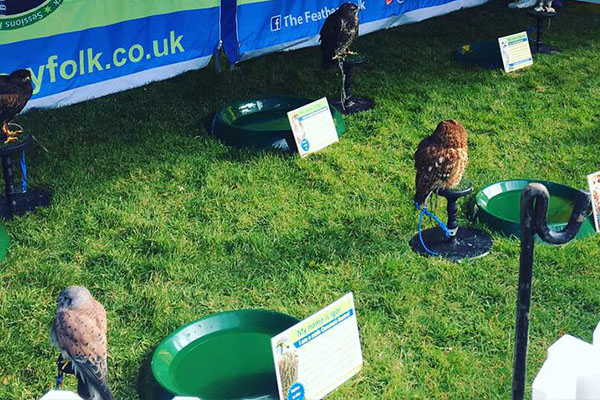
Birds are well spaced out on their perches, with constant access to water. Info signs also explain what each species is. Birds are all sat calmly on perches with relaxed body language.
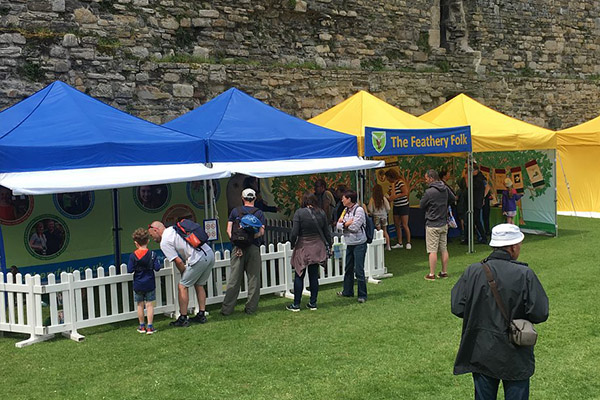
Substantial fencing around the static display allows public to view, without getting too close to the birds.
Birds are also undercover to keep them out of direct weather.
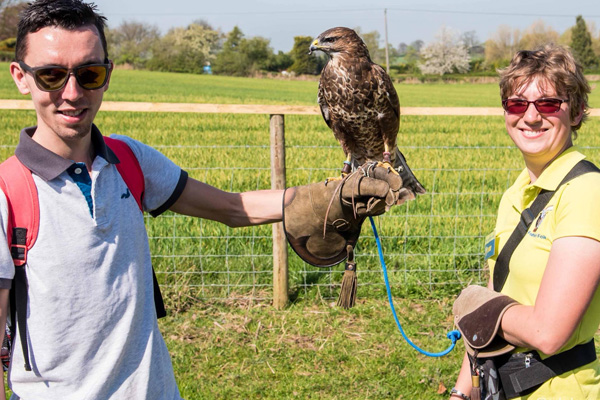
Bird being handled in a secure position by its equipment on the glove. Handler is nearby to assist. Bird is secured to the handler with a falconry knot. The bird shows calm body language while sat on glove.
Examples of a poor display setup
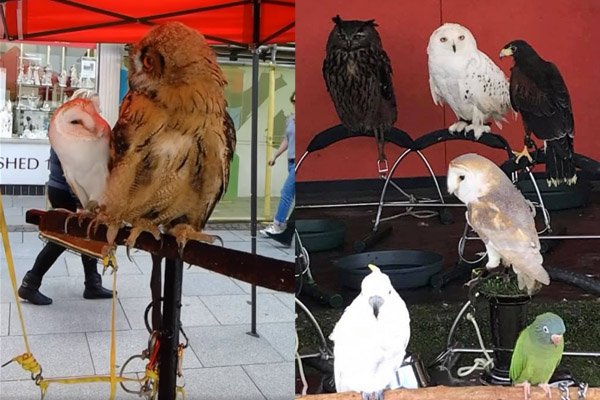
1. Mixed species on an unsuitable makeshift perch together, with risk of hanging if they fly off, or injury if one attacks the other.
2. Multiple mixed species tethered far too close together risking injuries or death.
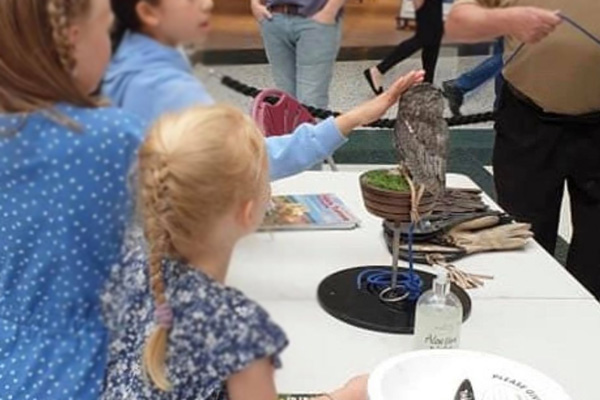
Bird perched on table top. No access to water, and easy access for general public to freely stroke the bird (which is not safe or appropriate).
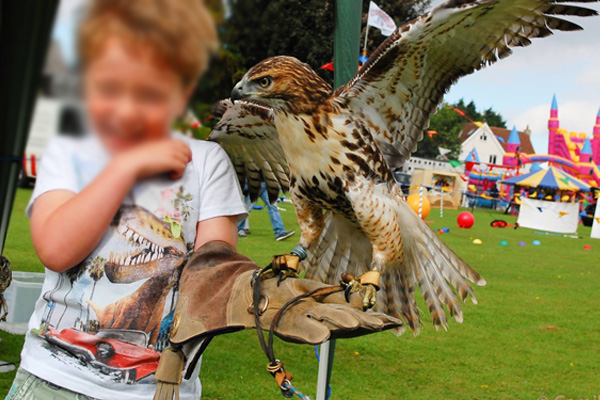
Bird being handled is not being held securly in fist. Could easily lead to injury of child or bird, if bird is spooked. Bird is also showing a threatened stance with raised wings and tight feathers on body. This is a situation that could get out of control very quickly.
The Birds
Just by looking at the birds themselves can often give a big clue as to how they are looked after.
The bird’s general demeanor.
Are the birds sat calmly on their perches, maybe with one foot tucked up, or are they constantly jumping about and off their perch, pulling on their leashes? This is called bating. The odd bait is not unusual as a bird may catch sight of something that interests it or spooks it, but if a bird is doing it constantly this could be a sign that the bird is feeling overwhelmed and unsafe in their surroundings. Actions should be taken by those on display to calm the bird and/or remove it from the display where appropriate.
Are the birds clean? Are their feathers shiny and clean, free from dirt and mutes (excrement)?
Same as for their feet and beak, the birds should be clean and not caked in dirt, mutes and old food. Of course it’s easy for a bird to get a bit messy through the day, especially if they have just eaten. But it should be simple to tell the difference between a bird that has managed to get itself a bit dirty and a bird that has been left to sit in its own filth for multiple days. Settled and relaxed birds bathe and preen regularly.
Do the feathers look damaged/broken, or are they in good condition?
Look at the ends of the feathers, especially on their wing tips and tail. Are the feathers all complete or are they all broken and snapped? If a lot or all of the feathers are broken this will seriously hinder the bird’s ability to fly and can be a sign of inadequate housing or bad husbandry.
Look at the equipment the birds are wearing. Even if you don’t know what it all is does it generally look clean and in good condition?
If it looks like leather, does the leather look clean, soft and supple, or does it look old, dry and hard? Are there any parts that look worn out or as if they may snap? As with the cleanliness of the bird, the cleanliness of the equipment can suggest that birds aren’t kept in clean housing and that it isn’t checked and maintained to ensure its not injuring the bird and isn’t going to fail, risking losing the bird completely. Whilst looking at the equipment around the bird’s feet do they have any rings around their legs and are these rings above the anklet (the leather cuff that goes around a bird’s leg)? The ring should be above the anklet as if it’s below there is a risk of it rubbing against the bird’s foot and leg, possibly causing injury.
Look at the beak of the bird and the cere (the fleshy bit above the beak where the nares (nostrils) are).
The beak should be in nice condition and not overgrown, preferably free of chips and splits (these sometimes occur naturally but an overgrown beak is more susceptible to serious splits and chips). Is the cere clean and smooth, or does it look bruised, scabby or damaged?
Examples of good bird condition
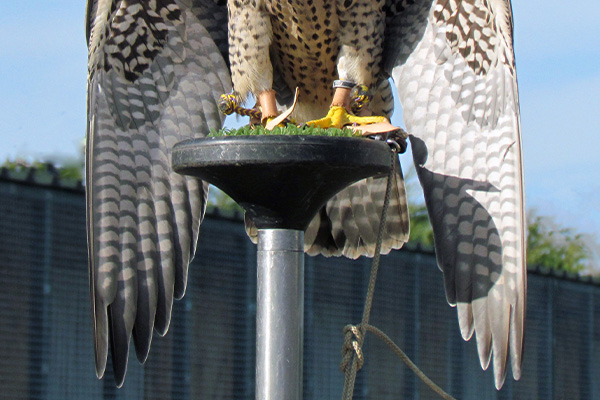
Excellent feather condition - no broken feathers on wings or tail. Feathers are very clean and regularly preened.

Feathers clean from food and mutes. Bright eyed and alert looking owl.

Birds sat calmly on perches. Feathers are relaxed (not 'sucked in') on their bodies, showing good body language and calm demeanour.
Examples of poor bird condition

All 12 tail feathers of this falcon are broken. Over half of the length of full tail is missing. This bird would not be able to fly properly.
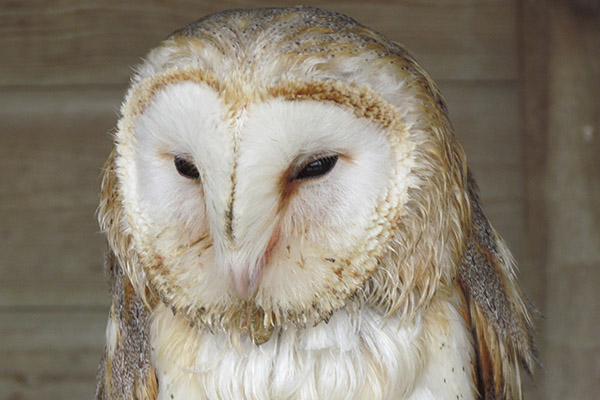
Facial feathers are heavily caked from food. This could be down to lake of suitable bathing oportunities and poor husbandry.
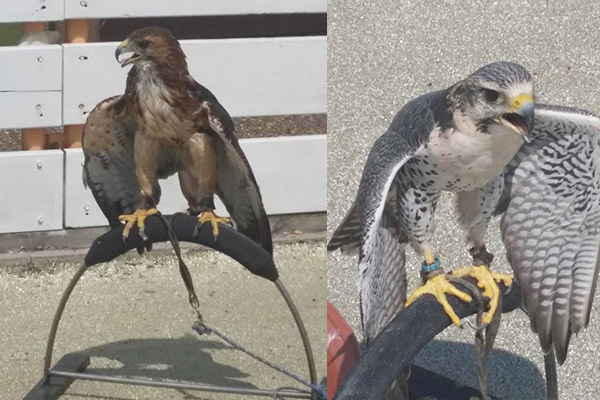
Birds very stressed from overheating. No access to water or shade to provide relief from the weather. Heavy panting and dropped wings shows birds are sufferinf extreme heat.
If you do have questions or concerns...
Of course, this is just a guide and some of the things listed above can be reasonably explained, so the first thing to do if you see anything that concerns you is to speak politely to the people running the display and ask them any questions you may have.
They should be able to talk to you in a calm and polite way addressing your concerns. If they seem immediately defensive or seem to want to avoid talking to you and answering your questions that should raise a red flag.
If after speaking to them you still have concerns, then you could speak to the organisers of the event/owners of the venue where the birds are being displayed about what you have seen. You could also take photos and speak to the local authority or council about the display and any worries you have. They will then be able to investigate further.




